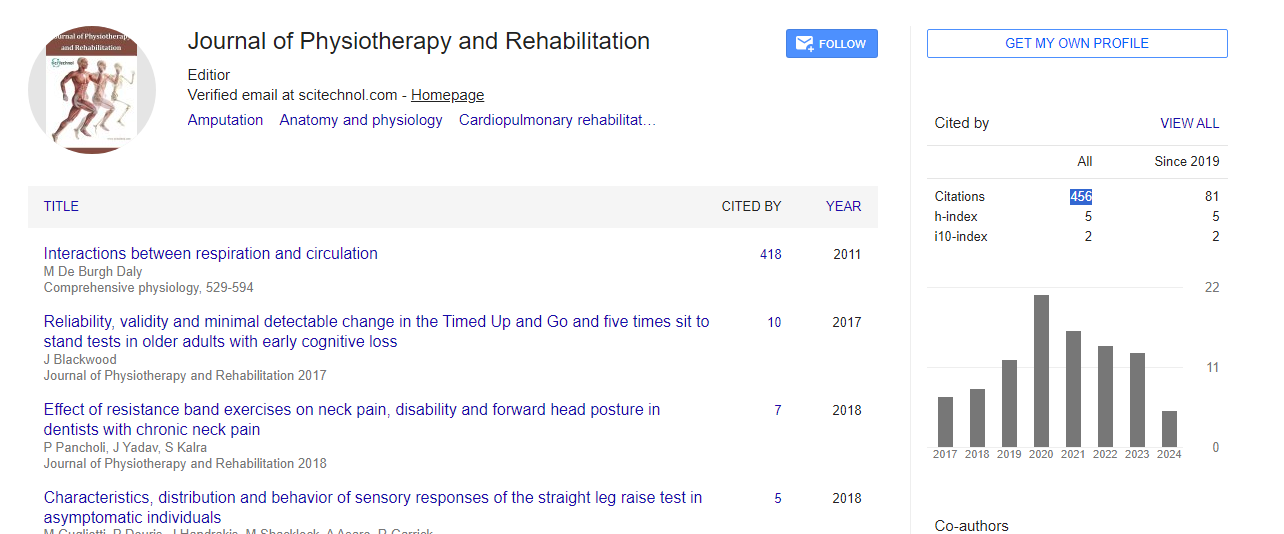Commentary, J Physiother Rehabi Vol: 8 Issue: 6
Impact of Physiotherapy on Muscular, Skeletal and Neural Rehabilitation through an In-Depth Analysis of Anatomy and Physiology in Recovery
Shimizu Yenz*
1Department of Physiotherapy, University of Parma, Parma, Italy
*Corresponding Author: Shimizu Yenz,
Department of Physiotherapy, University
of Parma, Parma, Italy
E-mail: yenzshim@conz.it
Received date: 23 November, 2024, Manuscript No. JPTR-24-155483;
Editor assigned date: 25 November, 2024, PreQC No. JPTR-24-155483 (PQ);
Reviewed date: 09 December, 2024, QC No. JPTR-24-155483;
Revised date: 17 December, 2024, Manuscript No. JPTR-24-155483 (R);
Published date: 24 December, 2024, DOI: 10.4172/JPTR.1000195.
Citation: Yenz S (2024) Impact of Physiotherapy on Muscular, Skeletal and Neural Rehabilitation through an In-Depth Analysis of Anatomy and Physiology in Recovery. J Physiother Rehabi 8:6.
Description
Physiotherapy plays an essential role in the rehabilitation of muscular, skeletal and neural injuries by using a deep understanding of anatomy and physiology. These fields provide the foundational knowledge needed to assess, treat and guide recovery from various conditions affecting the muscles, bones and nerves. By modifying interventions to the specific anatomical structures and physiological processes involved, physiotherapists can help patients recover efficiently, regain function and improve their quality of life. Muscular rehabilitation is often one of the primary focuses of physiotherapy, as many injuries and conditions, such as strains, sprains and muscle imbalances, result in compromised muscle function. A thorough understanding of muscle anatomy and physiology is vital for designing effective rehabilitation programs. Muscles are made up of fibers that contract to produce movement and they are highly responsive to exercise, stretching and manual therapy. However, injury to muscles, such as tears or strains, can disrupt their function and cause pain. Physiotherapists estimate the extent of muscle damage by understanding the muscle’s role in movement and its specific anatomical location. This helps to create targeted rehabilitation exercises aimed at strengthening the affected muscle, restoring range of motion and preventing further injury. Techniques such as active release therapy, deep tissue massage and stretching are often employed to promote healing and reduce muscle tension.
The skeletal system also plays a critical role in the overall mobility and function. Skeletal rehabilitation is essential in cases of fractures, joint dislocations or degenerative conditions such as osteoarthritis. The bones provide structural support to the body, protect internal organs and facilitate movement by acting as levers for muscles.
Physiotherapists working with skeletal injuries or conditions rely on their knowledge of bone anatomy, joint function and the healing process to design appropriate rehabilitation strategies. Rehabilitation may involve the careful restoration of bone alignment through physical manipulation, followed by exercises to increase joint mobility and strength. In the case of degenerative bone conditions, such as osteoarthritis, physiotherapy focuses on improving joint function, reducing pain and maintaining or enhancing mobility through lowimpact exercises, stretching and strengthening routines.
The neural system, encompassing the brain, spinal cord and peripheral nerves, is also integral to rehabilitation. Neural rehabilitation is especially important when nerve injuries or conditions, such as sciatica, carpal tunnel syndrome or spinal cord injuries, affect motor control and sensation. Nerves transmit signals between the brain and the body, allowing for coordinated movement and sensory perception. Injuries or compression of nerves can result in pain, weakness, numbness or paralysis, making rehabilitation essential to restoring proper nerve function. Physiotherapists with expertise in neural anatomy and physiology are able to assess the impact of nerve damage and determine the best course of treatment. This can include nerve mobilization techniques, manual therapy and exercises designed to improve nerve gliding and function.
Understanding the interaction between the muscular, skeletal and neural systems is essential in treating patients with complex conditions that involve multiple body systems. For example, individuals recovering from a stroke may experience weakness or paralysis due to damage to the brain’s motor control centers, as well as musculoskeletal stiffness and nerve damage. In these cases, physiotherapists must consider the whole body and design a rehabilitation plan that targets all affected systems. Exercises that improve muscle strength, joint mobility and neural function work synergistically to promote recovery. Likewise, for patients with chronic pain conditions, such as fibromyalgia or complex regional pain syndrome, physiotherapists may use a combination of approaches that address muscle weakness, joint dysfunction and nerve sensitivity to alleviate pain and improve function.
Conclusion
Physiotherapy is an essential component of the rehabilitation process for muscular, skeletal and neural injuries. By integrating a comprehensive understanding of anatomy and physiology into treatment, physiotherapists can design personalized rehabilitation plans that address the specific needs of each patient. This knowledge allows for more targeted interventions, faster recovery and better outcomes for patients experiencing a wide range of injuries and conditions. Whether focusing on muscle strength, bone healing or nerve function, physiotherapy plays an essential role in helping individuals recover mobility, alleviate pain and improve their overall quality of life.
 Spanish
Spanish  Chinese
Chinese  Russian
Russian  German
German  French
French  Japanese
Japanese  Portuguese
Portuguese  Hindi
Hindi 